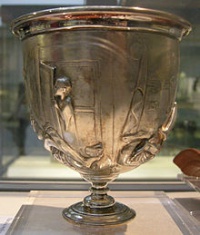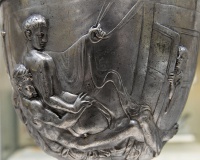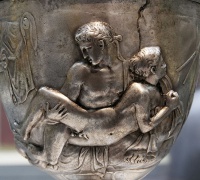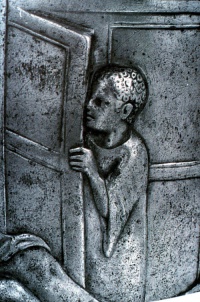Warren Cup: Difference between revisions
No edit summary |
|||
| Line 13: | Line 13: | ||
|[[Image:Warren Cup boy door 20thCentury london British Museum.jpg|200px]] | |[[Image:Warren Cup boy door 20thCentury london British Museum.jpg|200px]] | ||
|} | |} | ||
The Warren Cup is a piece of convivial silver, usually dated to the time of the Julio-Claudian dynasty (1st century AD), that depicts two scenes of male-male sex.<ref>John Pollini, "The Warren Cup: Homoerotic Love and Symposial Rhetoric in Silver," ''Art Bulletin'' 81.1 (1999) 21–52. John R. Clarke, ''Looking at Lovemaking: Constructions of Sexuality in Roman Art 100 B.C.–A.D. 250'' (University of California Press, 1998, 2001), p. 61, asserts that the Warren cup is valuable for art history and as a document of Roman sexuality precisely because of its "relatively secure date."</ref> It has been argued<ref>Pollini, "The Warren Cup," ''passim''.</ref> that the two sides of this cup represent the duality of pederastic tradition at Rome, the Greek in contrast to the Roman. On the "Greek" side, a bearded, mature man is mounted by a young but muscularly developed male in a rear-entry position. The young man, probably meant to be 17 or 18, holds on to a sexual apparatus for maintaining an otherwise awkward or uncomfortable sexual position. A child-slave watches the scene furtively through a door ajar. The "Roman" side of the cup shows a ''[[puer delicatus]]'', age 12 to 13, held for intercourse in the arms of an older male, clean-shaven and fit. The bearded pederast may be Greek, with a partner who participates more freely and with a look of pleasure. His counterpart, who has a more severe haircut, appears to be Roman, and thus uses a slave boy; the myrtle wreath he wears symbolizes his role as an "erotic conqueror".<ref>Pollini, "Warren Cup," pp. 35–37, 42.</ref> The cup may have been designed as a conversation piece to provoke the kind of dialogue on ideals of love and sex that took place at a Greek [[symposium]].<ref>Pollini, "Warren Cup," p. 37.</ref><ref>[http://en.wikipedia.org/wiki/Homosexuality_in_ancient_Rome Homosexuality in ancient Rome]</ref> | The Warren Cup is a piece of convivial silver, usually dated to the time of the Julio-Claudian dynasty (1st century AD), that depicts two scenes of male-male sex.<ref>John Pollini, "The Warren Cup: [[Homoerotic]] Love and Symposial Rhetoric in Silver," ''Art Bulletin'' 81.1 (1999) 21–52. John R. Clarke, ''Looking at Lovemaking: Constructions of Sexuality in Roman Art 100 B.C.–A.D. 250'' (University of California Press, 1998, 2001), p. 61, asserts that the Warren cup is valuable for art history and as a document of Roman sexuality precisely because of its "relatively secure date."</ref> It has been argued<ref>Pollini, "The Warren Cup," ''passim''.</ref> that the two sides of this cup represent the duality of pederastic tradition at Rome, the Greek in contrast to the Roman. On the "Greek" side, a bearded, mature man is mounted by a young but muscularly developed male in a rear-entry position. The young man, probably meant to be 17 or 18, holds on to a sexual apparatus for maintaining an otherwise awkward or uncomfortable sexual position. A child-slave watches the scene furtively through a door ajar. The "Roman" side of the cup shows a ''[[puer delicatus]]'', age 12 to 13, held for intercourse in the arms of an older male, clean-shaven and fit. The bearded pederast may be Greek, with a partner who participates more freely and with a look of pleasure. His counterpart, who has a more severe haircut, appears to be Roman, and thus uses a slave boy; the myrtle wreath he wears symbolizes his role as an "erotic conqueror".<ref>Pollini, "Warren Cup," pp. 35–37, 42.</ref> The cup may have been designed as a conversation piece to provoke the kind of dialogue on ideals of love and sex that took place at a Greek [[symposium]].<ref>Pollini, "Warren Cup," p. 37.</ref><ref>[http://en.wikipedia.org/wiki/Homosexuality_in_ancient_Rome Homosexuality in ancient Rome]</ref> | ||
==References== | ==References== | ||
Revision as of 13:48, 18 May 2015
"The Warren Cup is an ancient Roman silver drinking cup decorated in relief with two images of male (Pedosexual) same-sex acts. The cup is named after its first modern owner, the collector and writer Edward Perry Warren, and was acquired by the British Museum in 1999 for the sum of 1.8 million pounds. It is usually dated to the time of the Julio-Claudian dynasty (1st century AD), but doubts have been raised about its authenticity."[1] It was bought in Jerusalem and said to have been found near the city in Battir[2] (ancient Bethther), with coins of the emperor Claudius, possibly buried during the upheavals of the Jewish Revolt. According to the British Museum Director:[2]
We don't know for certain, but it's thought that the Warren Cup was found buried at Bittir, a town a few miles south-west of Jerusalem. How it got to this location is a mystery, but we can make a guess. We can date the making of the cup to around the year 10. About 50 years later, the Roman occupation of Jerusalem sparked tensions between the rulers and the Jewish community, and in AD 66 that exploded and the Jews took back the city by force. There were violent confrontations, and it is thought that our cup may have been buried at this date by the owner fleeing from the fighting.
- (Note: Due to the current moral panic in The United Kingdom, claims against the Warren Cup’s authenticity should be considered as suspect as possibly being revisionist based on political motivations.) [3]
The Warren Cup is a piece of convivial silver, usually dated to the time of the Julio-Claudian dynasty (1st century AD), that depicts two scenes of male-male sex.[4] It has been argued[5] that the two sides of this cup represent the duality of pederastic tradition at Rome, the Greek in contrast to the Roman. On the "Greek" side, a bearded, mature man is mounted by a young but muscularly developed male in a rear-entry position. The young man, probably meant to be 17 or 18, holds on to a sexual apparatus for maintaining an otherwise awkward or uncomfortable sexual position. A child-slave watches the scene furtively through a door ajar. The "Roman" side of the cup shows a puer delicatus, age 12 to 13, held for intercourse in the arms of an older male, clean-shaven and fit. The bearded pederast may be Greek, with a partner who participates more freely and with a look of pleasure. His counterpart, who has a more severe haircut, appears to be Roman, and thus uses a slave boy; the myrtle wreath he wears symbolizes his role as an "erotic conqueror".[6] The cup may have been designed as a conversation piece to provoke the kind of dialogue on ideals of love and sex that took place at a Greek symposium.[7][8]
References
- ↑ http://en.wikipedia.org/wiki/Warren_Cup
- ↑ Jump up to: 2.0 2.1 History of the World - About: Transcripts - Episode 36 - Warren Cup
- ↑ Artist’s Work Removed from Tate
- ↑ John Pollini, "The Warren Cup: Homoerotic Love and Symposial Rhetoric in Silver," Art Bulletin 81.1 (1999) 21–52. John R. Clarke, Looking at Lovemaking: Constructions of Sexuality in Roman Art 100 B.C.–A.D. 250 (University of California Press, 1998, 2001), p. 61, asserts that the Warren cup is valuable for art history and as a document of Roman sexuality precisely because of its "relatively secure date."
- ↑ Pollini, "The Warren Cup," passim.
- ↑ Pollini, "Warren Cup," pp. 35–37, 42.
- ↑ Pollini, "Warren Cup," p. 37.
- ↑ Homosexuality in ancient Rome
External links
- BBC:A History of The World
- BBC:A History of The World Episode 36 - Warren Cup
- Warren Cup (Wikipedia article)



